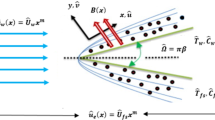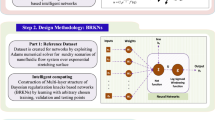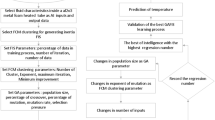Abstract
A mathematical flow model is envisioned to predict heat and mass transport of bio-magnetic ternary hybrid nanofluid (THNF) flow of different shapes over a moving wedge with radiation effect. The nonsimilar variables led the envisaged mathematical flow model to the physical flow problem. The shooting technique together with Runge-Kutta-Fehlberg’s fourth fifth-order (RKF-45) integration scheme is involved in computing the non-linear system of ordinary differential equations (ODEs). Influence of various physical parameters on friction factor \(\left({\check{C}}_{fx}\right)\), rate of heat transport \(\left({\check{H}}_{tx}\right)\), Sherwood number\(\left({\check{S}}_{hx}\right)\), and motile microorganisms’ flux \(\left({\check{N}}_{hx}\right)\) have been examined and visualized through graphs. Furthermore, the multi-output adaptive neuro-fuzzy inference system (MANFIS) simulation was developed and tested to predict the thermal and energy transport of bio ternary hybrid nanofluid flow. The physical parameters and the physical quantities such as the friction factor \(\left({\check{C}}_{fx}\right)\), rate of heat transport \(\left({\check{H}}_{tx}\right)\)Sherwood number\(\left({\check{S}}_{fx}\right)\), and motile microorganisms’ flux \(\left({\check{N}}_{hx}\right)\) are the input and output of the established MANFIS simulation. The RMSE, MAE, MSE, sum of squared error, and R2 of statistical indicators values for \(\left({\check{C}}_{fx}\right)\), \({\check{H}}_{tx}\) \({\check{S}}_{hx}\), and \({\check{N}}_{hx}\)were calculated using MANFIS. The predicted values are very close to the numerical results, and the coefficient of determination R2 of \({\check{C}}_{fx}\), \({\check{H}}_{tx}\), \({\check{S}}_{hx}\), and \({\check{N}}_{hx}\) are 0.9602, 0.9928, 0.9847, and 0.9859, respectively, indicating the best settlement. However, the results show that ternary hybrid nanofluid with blade-shaped nanoparticle intensifies rate of heat transport as compared to other shapes of hybrid nanofluid.




















Similar content being viewed by others
Abbreviations
- HNFs:
-
hybrid nanofluids
- THNFs:
-
ternary hybrid nanofluids
- MHD:
-
magnetohydrodynamic
- RKF-45:
-
Runge-Kutta-Fehlberg’s fourth fifth-order
- ODEs:
-
ordinary differential equations
- 2D:
-
two dimensions
- 3D:
-
three dimensions
- ANFIS:
-
adaptive neuro-fuzzy inference system
- MANFIS:
-
multi-output adaptive neuro-fuzzy inference system
- ANN:
-
artificial neural networks
- FL:
-
fuzzy logic
- MLP:
-
multilayer perceptron
- RMSE:
-
root-mean-squared error
- MAE:
-
mean absolute error
- MSE:
-
mean square error
- SSE:
-
sum of squared error
- R2 :
-
coefficient of determination
- MIMO:
-
multiple input and multiple output
- MF:
-
membership function
References
Choi SUS (1995) Enhancing thermal conductivity of fluids with nanoparticles Proceedings of the 1995 ASME International Mechanical Engineering Congress and Exposition, FED 231/MD 66:99-105.
Prasad KV, Vajravelu K, Vaidya H, Van Gorder RA (2017) MHD flow and heat transfer in a nanofluid over a slender elastic sheet with variable thickness. Results Phys 7:1462–1474
Hamid M, Usman M, Ul Haq R, Tian Z (2021) A Galerkin approach to analyze MHD flow of nanofluid along converging/diverging channels. Arch Appl Mech 91(5):1907–1924
Rasheed HU, Islam S, Helmi MM, Alsallami SA, Khan Z, Khan I (2021) An analytical study of internal heating and chemical reaction effects on MHD flow of nanofluid with convective conditions. Crystals. 11(12):1523
Rama Devi SVV, Gnaneswara Reddy M (2022) Parametric analysis of MHD flow of nanofluid in stretching sheet under chemical sensitivity and thermal radiation. Heat Transfer 51(1):948–975
Devi SPA, Devi SSU (2016) Numerical investigation of hydromagnetic hybrid CuAl2O3/water nanofluid flow over a permeable stretching sheet with suction, International Journal of Nonlinear Sciences and Numerical. Simulation. 17:249–257
Al-Hanaya AM, Sajid F, Abbas N, Nadeem S (2020) Effect of SWCNT and MWCNT on the flow of micropolar hybrid nanofluid over a curved stretching surface with induced magnetic field. Sci Rep 10(1):1–18
Mahanthesh B, Shehzad SA, Ambreen T, Khan SU (2021) Significance of Joule heating and viscous heating on heat transport of MoS2–Ag hybrid nanofluid past an isothermal wedge. J Therm Anal Calorim 143(2):1221–1229
Anuar NS, Bachok N, Pop I (2021) Influence of buoyancy force on Ag-MgO/water hybrid nanofluid flow in an inclined permeable stretching/shrinking sheet. Int Commun Heat Mass Transfer 123:105236
Shanmugapriya M, Sundareswaran R, Senthil Kumar P (2021) Heat and mass transfer enhancement of MHD hybrid nanofluid flow in the presence of activation energy. Int J Chem Eng 2021: Article ID 9473226
Kakar N, Khalid A, Al-Johani AS, Alshammari N, Khan I (2022) Melting heat transfer of a magnetized water-based hybrid nanofluid flow past over a stretching/shrinking wedge. Case Stud Thermal Eng 30:101674
Zayan M, Rasheed AK, John A, Muniandi S, Faris A (2021) Synthesis and characterization of novel ternary hybrid nanoparticles as thermal additives in H2O. Chem Rxiv, Article in press. https://doi.org/10.26434/chemrxiv.13710130.v1
Manjunatha S, Puneeth V, Gireesha BJ, Chamkha A (2022) Theoretical study of convective heat transfer in ternary nanofluid flowing past a stretching sheet. J Appl Comput Mech 8(4):1279–1286
Puneeth V, Manjunatha S, Ganesh Kumar K, Gnaneswara Reddy M (2022) Perspective of multiple slips on 3D flow of Al2O3–TiO2–CuO/H2O ternary nanofluid past an extending surface due to non-linear thermal radiation. Waves Random Complex Media, Article in press. https://doi.org/10.1080/17455030.2022.2041766
Hou E, Wang F, Nazir U, Sohail M, Jabbar N, Thounthong P (2022) Dynamics of tri-hybrid nanoparticles in the rheology of pseudo-plastic liquid with Dufour and Soret effects. Micromachines. 2022(13):201
Arif M, Kumam P, Kumam W, Mostafa Z (2022) Heat transfer analysis of radiator using different shaped nanoparticles water-based ternary hybrid nanofluid with applications: a fractional model. Case Stud Thermal Eng 31:101837
Shi QH, Hamid A, Khan MI, Kumar RN, Gowda RJ, Prasanna kumara BC, Chung JD (2021) Numerical study of bio-convection flow of magneto-cross nanofluid containing gyrotactic microorganisms with activation energy. Sci Rep 11(1):1–15
Madhukesh JK, Ramesh GK, Aly EH, Chamkha AJ (2022) Dynamics of water conveying SWCNT nanoparticles and swimming microorganisms over a Riga plate subject to heat source/sink. Alex Eng J 61(3):2418–2429
Hussain S, Aly AM, Öztop HF (2022) Magneto-bioconvection flow of hybrid nanofluid in the presence of oxytactic bacteria in a lid-driven cavity with a streamlined obstacle. Int Commun Heat Mass Transfer 134:106029
Nabwey HA, EL-Kabeir SMM, Rashad AM, Abdou MMM (2022) Gyrotactic microorganisms mixed convection flow of nanofluid over a vertically surfaced saturated porous media. Alex Eng J 61(3):1804–1822
Khashi’ie NS, Arifin NM, Pop I, Nazar R (2021) Dual solutions of bioconvection hybrid nanofluid flow due to gyrotactic microorganisms towards a vertical plate. Chin J Phys 72:461–474
Khan MN, Ahmad S, S. (2021) Nadeem Flow and heat transfer investigation of bio–convective hybrid nanofluid with triple stratification effects. Phys Scr 96(6):065210
Naveed Khan M, Ahmad S, Ahammad NA, Alqahtani T, Algarni S (2022) Numerical investigation of hybrid nanofluid with gyrotactic microorganism and multiple slip conditions through a porous rotating disk. Waves Random Complex Media, Article in press. https://doi.org/10.1080/17455030.2022.2055205
Jang JS (1993) ANFIS: adaptive-network-based fuzzy inference system. IEEE Trans Syst Man Cybern 23(3):665–685
Elayarani M, Shanmugapriya M, Kumar PS (2021) Intensification of heat and mass transfer process in MHD Carreau nanofluid flow containing gyrotactic microorganisms. Chem Eng Process-Process Intensif 160:108299
Nosratabadi S, Ardabili S, Lakner Z, Mako C, Mosavi A (2021) Prediction of food production using machine learning algorithms of multilayer perceptron and ANFIS. Agriculture. 11(5):408
Sharma P, Said Z, Memon S, Elavarasan RM, Khalid M, Nguyen XP, Arıcı M, Hoang AT, Nguyen LH (2022) Comparative evaluation of AI-based intelligent GEP and ANFIS models in prediction of thermophysical properties of Fe3O4-coated MWCNT hybrid nanofluids for potential application in energy systems. Int J Energy Res, Article in press. https://doi.org/10.1002/er.8010
Said Z, Sharma P, Tiwari AK, Huang Z, Bui VG, Hoang AT (2022) Application of novel framework based on ensemble boosted regression trees and Gaussian process regression in modelling thermal performance of small-scale organic rankine cycle using hybrid nanofluid. J Clean Prod 360(1):132194
Benmiloud T (2010) Multi-output adaptive neuro-fuzzy inference system. In WSEAS international conference on neural networks 11:94–98
Ghaffari A, Khodayari A, Alimardani F, Sadati H (2012) Manfis-based overtaking maneuver modeling and prediction of a driver-vehicle-unit in real traffic flow, International Conference on Vehicular Electronics and Safety (ICVES 2012) 387-392.
Fattahi H, Agah A, Soleimanpourmoghadam N (2018) Multi-output adaptive neuro-fuzzy inference system for prediction of dissolved metal levels in acid rock drainage: a case study. J AI Data Mining 6(1):121–132
Mukhtar M, Khudher D, Kalganova T (2021) A control structure for ambidextrous robot arm based on multiple adaptive neuro-fuzzy inference system. IET Control Theory Appl 15(11):1518–1532
Tiruneh GG, Fayek AR (2022) Hybrid GA-MANFIS model for organizational competencies and performance in construction. J Constr Eng Manag 148(4):04022002
Krishna SSG, Shanmugapriya M (2021) Inquiry of MHD bioconvective non-Newtonian nanofluid flow over a moving wedge using HPM. Materials Today: Proceed 38:3297–3305
Gopi Krishna S, Shanmugapriya M, Senthil Kumar P (2022) Prediction of bio-heat and mass transportation in radiative MHD Walter-B nanofluid using MANFIS model. Math Comput Simul 201:49–67
Author information
Authors and Affiliations
Contributions
S. Gopi Krishna: investigation, methodology, and writing — original draft; M. Shanmugapriya: conceptualization, validation, and supervision; R. Sundareswaran: investigation, resources, and formal analysis; P. Senthil Kumar: conceptualization, validation, and supervision
Corresponding author
Ethics declarations
Competing interests
The authors declare no competing interests.
Additional information
Publisher’s note
Springer Nature remains neutral with regard to jurisdictional claims in published maps and institutional affiliations.
Rights and permissions
About this article
Cite this article
Krishna, S.G., Shanmugapriya, M., Sundareswaran, R. et al. MANFIS approach for predicting heat and mass transport of bio-magnetic ternary hybrid nanofluid using Cu/Al2O3/MWCNT nanoadditives. Biomass Conv. Bioref. 14, 11175–11190 (2024). https://doi.org/10.1007/s13399-022-02989-x
Received:
Revised:
Accepted:
Published:
Issue Date:
DOI: https://doi.org/10.1007/s13399-022-02989-x




